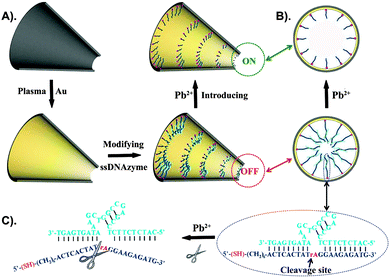
(A) Preparation of the lead(II) ion responsive gating; (B) mechanism of the ionic gating; (C) the used ssDNAzyme and its Pb2+-responsive mechanism. Transportation between cells in multicellular organisms is performed usually by the sophisticated “gate mechanisms”. For example, membrane bound proteins determine the passage of certain ions through cell membranes. However, the biological membranes are not stable towards changing external environments and artificial solid-state nanochannels are synthesized instead to mimic the membrane functions. At the present, special synthetic bio-mimetic materials, possessing a similar function as the biological materials in human life and in industrial production, have been developed extensively due to their great flexibility based on their geometry and size, excellent mechanical robustness, and multi-functional surface properties. These synthetically controllable nano-porous membranes are becoming a hot research topic in the biomimetic field. To date, many smart nanochannels have been developed. Siwy et al. reported a calcium induced voltage gating phenomenon in a synthetic single conical nanopore. Zheng et al. demonstrated a single biomimetic nanochannel that mimicked the binding and unbinding of ferrum(III) with transferrin. Recently, our group reported a series of research on ion activated nanochannels for potassium ions, zinc ions, mercury ions and silver ions. Such biomimetic smart nanochannels have the potential to be used in mimicking switches in advanced devices. A simple biomimetic ionic gate has been developed by modifying lead(II) ion responsive DNAzymes onto the inner surface of ion-etched polymer nanochannels. Chem. Commun., 2015 |

